If you thought cooking Christmas lunch for a dozen family members was stressful, imagine trying to create festive dishes for 12 million diners, all with their own peculiar tastes and budgets, and all willing to walk across the road if they don’t like what’s offered to them.
The British supermarket industry, competitive to a cut-throat degree at the best of times, treats the festive season as a key battleground. “Christmas is so important for supermarkets, financially and for their morale,” says Fraser McKevitt, head of retail and consumer insight at Kantar Worldpanel, a market research firm. McKevitt’s team has been tracking how Aldi and Lidl, the Germany-based discounters, have been breathing down the necks of the big four – Tesco, Sainsbury’s, Asda and Morrisons – along with Marks & Spencer and Waitrose. All are under pressure, but Christmas presents a golden opportunity for the legacy supermarkets to fight back. Kantar calculates that households spent on average £129.47 at a supermarket in the week before Christmas last year, compared with £79.66 in a normal week.
The biggest weapon in the Christmas battle is new product development. Any of the supermarkets can cut prices on a tin of Quality Street or a bottle of champagne; but to really get customers to spend, they need to prove “differentiation” through their own-label, premium dishes. These are developed by in-house kitchens and innovation centres.
Here, the men and women who spend months trying to work out what you want to eat alongside your turkey, or at a Boxing Day buffet, share the secrets of their test kitchen.
‘We’re looking for the next little black dress of food’
Jonathan Moore, executive chef, Waitrose
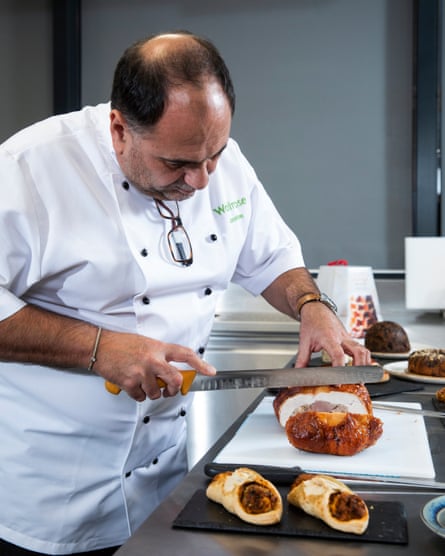
Most supermarket development chefs start working on Christmas 18 months before the big day. Jonathan Moore says some of his ideas began six years before products hit the shelf. He spends a lot of his time eating in restaurants – “It’s not eating out. I go to taste stuff. There’s a big difference,” he insists – as well as visiting food conferences to pick up ideas. He remembers attending StarChefs in 2012, an annual international chefs’ conference in New York. “Loads of cool mixologists were there, and they were burning rosemary, burning orange zest. It was a ‘doink’ moment,” he says; bitter, particularly bitter orange, has become a key flavour in a lot of Waitrose’s Christmas dishes this year.
The bitter trend first went mainstream in cocktails, as Aperol spritz and negronis became popular a few years ago. “Then brassicas and kale start appearing everywhere. So you go, bitter, kale, health, and you have this perfect storm when you think: we need to start developing stuff around this.” This year, the supermarket has used bitter orange in savoury Christmas dishes such as venison haunch with bitter orange and juniper, and chantenay carrots with bitter orange and juniper glaze, as well as sweet products: a dark chocolate and orange stollen wreath.
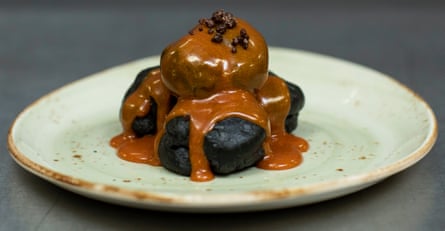
Moore, 58, started out as a hotel chef and won a Michelin star in the mid-80s working at Les Semailles, Bristol. He now works in Waitrose’s £1.5m innovation centre, which opened this summer at the supermarket’s sprawling head office in Bracknell, Berkshire. The kitchen includes six workstations (one for every chef in his team), all with a sous vide machine; there are smokers, indoor barbecues, blow torches and walk-in fridges.
He is in charge of all Waitrose’s own-brand food, as well as the Heston Blumenthal range, which is developed in collaboration with a team from Blumenthal’s Fat Duck restaurant. Waitrose has never managed to replicate the extraordinary success of Heston’s hidden orange Christmas pudding, launched in 2010; the £13 puddings changed hands for £250 on eBay after the supermarket ran out. He is hopeful that Heston’s “profiter’coals”, black profiteroles filled with an orange crème pâtissière and finished with popping candy and an orange caramel sauce, will be more successful than 2016’s attempt: a banana bacon trifle. “At Christmas, a lot of people want to trade up and try something a little bit different. I think the bacon trifle was a stretch too far.”
“Food has become fashion. What is the next little black dress?” Moore asks, comparing Waitrose to Zara, a company interpreting the catwalk or, in his case, restaurants and street-food trends for the discerning mass market. “Some of our lines, even if they are hugely successful, will have a two-year life cycle.”
‘It’s showstopping, it’s fun: Christmas is fun’
Mark Richmond, head innovation and development chef, Asda
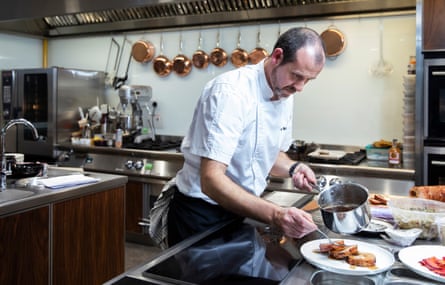
Wensleydale cheese with salted caramel, a super-sized gingerbread man encasing a chocolate mousse, a foot-long pig-in-blanket – a lot of the Christmas food at Asda can be a bit self-consciously wacky.
Head chef Mark Richmond explains the big pig-in-blanket (retailing at £5): “It’s a great talking point at the family table, it’s showstopping, it’s fun. And Christmas,” he pauses and smiles, “is fun. From a marketing perspective, this is a great product. It’s interesting for consumers, and it fits into our trend about sharing.” Many dishes are developed with an eye on how they will play on social media. Asda’s marketing team has calculated that the pig-in-blanket reached the news feeds of 1.14 million people by the second week of November; as a result, it has ordered 10,000 more in time for Christmas.
The quirky food created by Richmond, 42, in the development kitchen at Asda’s head office in the centre of Leeds, is rooted in months of trend analysis undertaken by his boss, Jo Johnson. As the head of innovation, she commissions reports from most of the big trend agencies and market research companies. She shows me a graph produced in the summer of 2017, which helped shape this year’s products. It’s a series of pictures and buzzwords along a curve. At one end is “mainstream” – gold, Nordic, premiumisation; in the middle is “gaining momentum” – unicorns, sharing, Christmas brunch, low/no alcohol; at the far end is “emergent” – plant-based, pink, rum, sustainability.

Richmond’s job is to interpret these graphs. “These trends evolve. The foot-long chocolate eclair [a 2017 Asda product] was the start of the size thing. We saw a lot of trends around making classics bigger.”
Asda has seen its turnover and profits hit by the relentless march of the discounters Aldi and Lidl, so its products need to be competitively priced. Richmond says he often gets thwarted by Asda’s buying teams, who want to keep costs low: “From a development perspective, it can be very difficult when it comes to price. What you’ve got to do is work with expensive ingredients and try to dilute cost in other ways.” Plans for a rhubarb gin mince pie this year, which were “bang on trend”, were ditched after Asda could not “make it stack up commercially with a supplier”, says Johnson.
But Richmond has managed to create a number of products that hit the “premiumisation” trend, including a sheep’s milk cheese (similar to a manchego) with truffle flecked through it. Supermarkets now have to appeal to all shoppers, regardless of budget, in the increasingly fickle retail world, he says. “People are shopping about more. Our core customers used to be ‘Asda mums’. Now we’re saying that anyone is an Asda customer.”
‘Ten years ago, we wouldn’t have had a meringue wreath’
Kate Ewart, product development director, Tesco
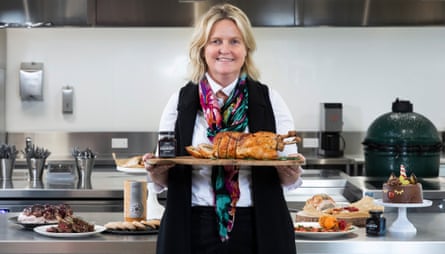
There is a mock sitting room at Tesco HQ, complete with sofas and a TV. It’s where consumers come to taste food “and feel relaxed”, says Kate Ewart, product development director at Tesco. “We video it all,” she says, pointing to discreet cameras. “So we can listen in on focus groups without intruding. We want them to feel comfortable.”
She adds: “We have a trained panel who can describe textures and flavours. If I am looking for the most succulent turkey, they will taste until we get the right recipe, the right brine. We screen them every year to ensure they have the right taste buds.” Ewart, 48, who has been at Tesco for 18 years, is a food technologist by training. She leads a team of 50 food developers and four chefs to create Tesco’s food range, and signs off all Christmas products. “The exec chefs come up with great ideas, but not necessarily with the individual products. Their job is to excite our developers, who will then brief suppliers as to the kind of things we’re looking for. And then suppliers submit ideas. I coordinate it all.”
Tesco is still the UK’s biggest supermarket, with 18m households shopping there at least once a month. It segments customers into six broad types, invented and named by its insights team, including young “Roshini”, who likes yoga, and “Carol”, who suffered heart failure five years ago and is on a tight budget. Ewart says she wants to ensure that Tesco has Christmas products for all those demographics.
One of its “showstopper” desserts is a £5 frozen black forest meringue wreath, which Ewart says is aimed at the likes of “Roshini, who Instagrams everything,” adding: “Everybody wants to be able to say, ‘My dinner is better than your dinner’, so they want it to look amazing. It has to be table presentable. Ten years ago, I don’t think we would have had a meringue wreath. But having more variety and visual display – that’s what it is really playing to.” Black forest gateau has been particularly embraced by Tesco this year, which has woven it through a dozen dishes, including savoury ones such as venison with a morello cherry glaze. The volume of black forest dishes is deliberate, says Ewart. “If you go into a restaurant and you have the tasting menu, everything complements each other. That’s what we’re trying to do: different tastes that come together.”
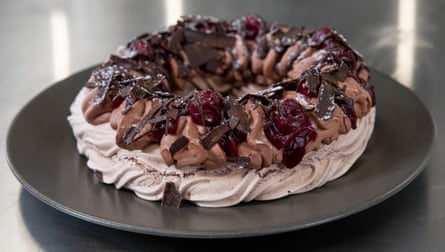
‘You want people to pick it up and say, “That’s clever”’
Jon Jones, development and innovation chef, Marks & Spencer
For Jon Jones, it really is Christmas every day. “I am always thinking about Christmas. You could see a bit of packaging and you think, ‘Oh God, that would be a brilliant platter.’”
Marks & Spencer has a mere 4% share of the UK’s grocery market. But when it comes to festive food it massively “out indexes”, as the industry jargon puts it, controlling more than 30% of the mince pie market and the largest share of the party food market. It expects to sell 140m pieces of party food this season. This is an area close to Jones’s heart. The first product he developed for M&S was “a lovely sweet pea blini, which we served with smoked salmon”. When he saw it on the shelf: “It was a beautiful moment. You want to go up to the shopper and say, ‘Thank you, I hope you enjoy it.’”
Jones, 31, who joined the company from Waitrose four years ago, says Christmas party food has become increasingly important as consumers entertain more frequently than they used to. It also gives him licence to be creative. “You can think outside the box in a way you can’t with the main meal,” he says, adding: “Party food tends to be brown and a bit greasy. So, you need some classics, but also some quirky products that people pick up and say, ‘That’s really clever.’”
In M&S’s development kitchen at the company’s HQ in London, he has worked on mini vegan burgers, sticky Asian-style chicken lollipops, and spicy pulled-pork tacos. “It’s not that Christmassy,” he admits, “but there’s only so many Christmassy things you can do.” The tacos tap into the Mexican street-food trend; at £7 for 10, they are not cheap, but those shopping at M&S at Christmas have larger budgets than average. Jones highlights its Belgian chocolate and cherry dessert. “We realised we had a very, very successful £20 price point dessert last year – the white chocolate wreath – so we wanted to do something with a similar ‘wow’. This has more layers, more textures. Yes, £20 is punchy. But it serves 10, so it’s £2 a portion.” The dish, inspired by a trip that Jones and his team took to Paris last year, is served in a rectangle shape with an intricate holly and berry pattern on top, using a mould M&S commissioned from its supplier. “This guarantees it will be unique. It’s Christmas: you want to bring it out and put it on the table and for people to go, ‘Wow, how did they do that?’ We’re always striving towards the ‘wow’.”
‘We tore last year’s mince pies apart. We had to improve’
Richard Jones, development chef, Morrisons

Last Christmas wasn’t the best for Richard Jones. “Our mince pies didn’t deliver great results,” he says, in the Morrisons “taste and test” kitchen in Bradford. “Sales were OK, but they didn’t feature very well in taste tests.” In a Which? magazine test, the mince pies came 11th out of 11, with the review saying the pastry was “cloying” and the mincemeat lacking spice.
Morrisons, with 12 million weekly customers, may be No 4 of the big four supermarkets, but it sells more than 5m boxes of mince pies over Christmas; a product its customers particularly care about. “Our core customer is a little bit older, very traditional in what they like. We have to get the traditional products absolutely right. We can play with a little bit of creativity, but our customers don’t want us to go too far.” Part of the company’s challenge is to persuade shoppers, more likely to cook from scratch, to trade up from basic turkey, trimmings and veg to better ingredients.
Unusually for a supermarket, Morrisons owns a lot of its own manufacturing sites, including three abattoirs and a prepared produce factory in Worsley, Greater Manchester. “Some customers will do everything from scratch and that’s great, but increasingly they want help,” says the 49-year-old. He points to the growth in cook-at-home meal kits, which have influenced Morrisons’ Christmas veg dishes, such as heritage carrots with cranberry and orange butter, made in the Worsley factory. “We prepare it to a certain point, but the customer can finish it off with a glaze or a butter.”

Ultimately, Jones’s job is to ensure the basics are done well, not least this year’s mince pies. After the poor reviews last year, “We took the pastry apart, we took the mince apart, then we looked at the design on top, how much dusting do you want, the packaging, everything. We had to make improvements.”
The 0.7% brandy content was changed to 3.3% brandy and 3.1% cider. It worked. The mince pies topped both BBC Good Food and Good Housekeeping tests, and came 3rd in the Which? rankings, which have just been published. Jones is thrilled. “I spend more time on mince pies and Christmas cake than any other product. I try not to have sleepless nights over them,” he smiles. “But they are really important.”
His assistant chef, Jon Coates, chips in. “Christmas is not the time to take risks. It’s high pressure – the poshest Sunday lunch any of us do. Do you really want to have flavours you don’t know? You don’t want people to pick something up and say: ‘What the hell is yuzu?’”
‘I eat everything on the menu – I exercise three hours a day’
Nicola Bramley, product development chef, Sainsbury’s
“A lot of what we do is blue-sky stuff,” says Nicola Bramley, explaining how she comes up with four “fashion flavours” that will dominate her Christmas range of food. “It’s reading restaurant menus, visiting food shows and events, buying all the food magazines, cookbooks, going on food trawls, walk around food markets, and premium retailers like Harrods and Selfridges.”
Her small office, across the corridor from the main test kitchen at the Sainsbury’s head office in London, is crammed with cookbooks, recipes torn from magazines, trend charts, restaurant menus and mood boards. The 35-year-old writes a “direction presentation” for the development team a year before products hit the shelves. This year’s four flavours are mulled pears, pomegranate fizz, caramelised chestnut, and gin botanicals: all on-trend, and all suitable for both sweet and savoury food.
Bramley does regular exercise most days, to burn off all the calories consumed as part of her job: “Sometimes you can do four or five restaurants in a day. You try to be restrained, but that never works; you end up eating everything on the menu,” she says. “I exercise for nearly three hours a day – I cycle to work, then I go to the gym. And yoga after work every few days.”

Not all her ideas end up on shelves or sold in the way they were originally conceived. “We development chefs are briefed not to worry about commercial considerations or manufacturing capabilities. It’s what’s going to look great, the amazing next thing. It’s then up to the product developer, buyer and technologist to work with the supplier to get as close to that as possible.” Inevitably, costs come into play; a £7 jewelled squash and red pepper vegan pilaf, using the pomegranate fizz flavour, was originally designed to be sold in a wreath, a popular shape this year. “It changed, because, do we really want to invest £20,000 in a new mould?” It is now sold in an ordinary dish. “It’s vegan, which is very on-trend, and a bit Middle Eastern, so I think it will do well.”
Sometimes technical issues cause a recipe to be changed. Bramley created – as party food – some duck bonbons with a sloe-gin sauce hidden in the centre. “They changed, because the supplier couldn’t quite get the quality of shred on the duck. They then tried with minced duck, which wasn’t very good. Venison worked a lot better.”
The dishes take more than a year to develop, because of all the toing and froing between product developers and suppliers; most dishes will go through five or six iterations. Before any dish is given the final signoff, it is tested by either a panel of consumers or Sainsbury’s staff – every dish has to receive at least a seven out of 10. “The venison bonbons have scored really well,” Bramley says. “But it’s difficult. Things I think are amazing and my favourites might not do as well as I hope. We’re in the London bubble, and I might be excited by mini lobster rolls or pulled jackfruit bonbons – but is that a trend in other areas of the country?”
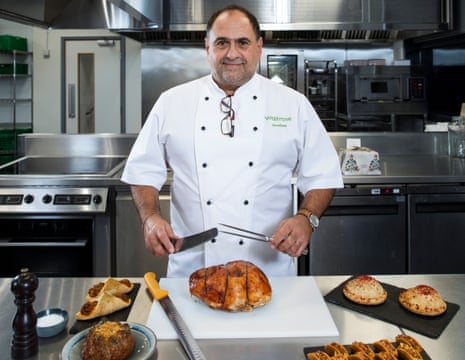
Comments (…)
Sign in or create your Guardian account to join the discussion